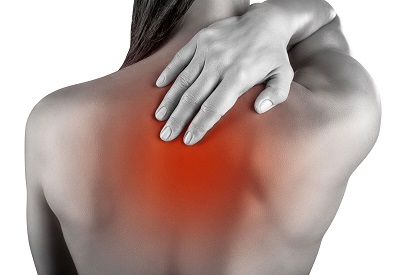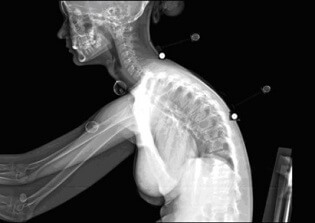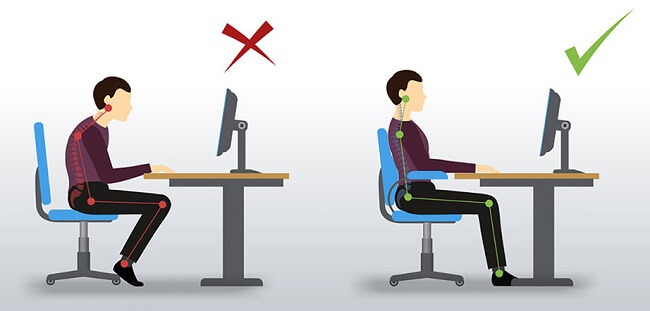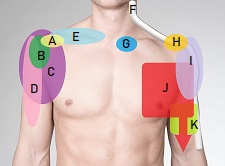- Home
- Diagnosis Guide
- Upper Back Pain
Pain Between Shoulder Blades
Written By: Chloe Wilson BSc (Hons) Physiotherapy
Reviewed By: SPE Medical Review Board

Upper back pain between shoulder blades is a common problem that can be really uncomfortable.
In most cases, it is fairly minor and recovers quickly with simple home treatments, but in some cases it can indicated something serious.
Pain in between shoulder blades is also known as interscapular pain and may present as a dull, burning, aching, stabbing or shooting pain anywhere in the upper back region. There may even be a lump on the back of the shoulder.
What Causes Pain Between Shoulder Blades?
There are lots of possible causes of pain between shoulder blades and here we are going to have a look at the common ones and how to tell whether there is something serious going on. We will then look at the best ways to treat pain between shoulder blades and stop it from coming back.
1. Muscle Problems
Muscle strain is the most common cause of upper back pain between shoulder blades. The main muscles found between the shoulder blades are the rhomboids, trapezius and paraspinal muscles. They work to support the upper back and control shoulder blade movement. Overloading these muscles can result in muscle strain
Muscle pain between the shoulder blades is usually caused by:
- Overuse: particularly with repetitive activities such as lifting weights, overhead throwing, swimming or DIY such as painting a ceiling
- Improper Lifting: picking up heavy items awkwardly or from a poor position e.g. spine twisted or reaching to lift something
- Carrying Heavy Items: e.g. shopping bags, particularly if you carry them in one hand or on one shoulder
- Weakness: weak muscles quickly become fatigued leading to a dull, achy pain between the shoulder blades
One of the best ways to reduce pain between the shoulder blades from muscle problems is to strengthen the muscles with scapular stabilization exercises.
In some cases, most typically with contact sports, falls or car accidents, the force of the load may be large enough to partially tear one of the muscles.
Pain between shoulder blades from muscle strain usually gets worse the more you do and builds up during the day. Stretching exercises can also help.
2. Poor Posture

Poor posture is a really common cause of upper back pain between shoulder blades. Sitting for long periods in a bad position can, overtime, cause structural changes in the bones and muscles which can lead to pain and trigger points.
Risk factors for developing interscapular pain from poor posture include:
- Prolonged Sitting: particularly affects people who spend a large portion of the day sitting down leaning over a laptop or keyboard.
- Slouching: sitting in a slouched position with our shoulders and head hunched forwards and lower back rounded places a great deal of tension and pressure through the lower neck and upper back, the muscles, ligaments and spinal discs
- Incorrect Chair: Sitting in chair that is the wrong height, doesn’t often any lower back support or is just generally uncomfortable is going to put your body in an awkward position and can lead to pain between the shoulder blades
- Incorrect Desk Set Up: Screen height, keyboard position and desk setup can all affect how you sit and if incorrect can put strain the upper back muscles
The best ways to combat pain between the shoulder blades from poor posture is to not only change your desk and chair set up (more on that coming up), but also to stretch and strengthen the upper back muscles.
3. Bone Problems
Some cases of pain between the shoulder blades come from problems in the cervical or thoracic spine rather than the surrounding muscles. There may be:
- Arthritis: Wear and tear of the spinal vertebrae
- Spinal Stenosis: narrowing of the tunnel through the spine where the spinal cord sits
- Scoliosis: Abnormal curvature of the spine
- Disc Disease: degenerative disc disease or a protrusion (bulging) of the spongy discs that sit between the spinal vertebrae
- Osteoporosis: weakening of the spinal bones which can result in compression fractures
- Dislocated Rib: when one of the ribs pops out of place
These can all cause pain in the spinal vertebrae themselves but can also lead to irritation of the surrounding nerves. This can result not only in a stabbing or burning pain between shoulder blades, but the pain may also refer down one or both arms and into the hands. Classic signs of associated nerve irritation are tingling, numbness and weakness. You can find out lots more in the nerve pain section.
4. Medical Conditions
Upper back pain between shoulder blades can sometimes be a sign of an underlying medical issue such as:
- Heart Condition: Rapid and very severe pain between the shoulder blades could indicate an aortic dissection, a tear in the heart’s largest artery. Heart attacks can also cause pain between shoulder blades and shortness of breath, particularly in women. Both of these conditions require immediate medical attention.
- Gall Bladder Disease: A stabbing pain between shoulder blades after eating may indicate a problem with the gall bladder and is often accompanied by stomach pain and nausea.
RELATED ARTICLE > What Causes Shoulder Blade Pain?
How Do I Know If It's Serious?
Most cases of interscapular pain are caused by something fairly minor, but in some cases, pain here can indicate a much more serious problem. But how can you tell?
See Urgent Medical Attention if your pain between the shoulder blades is accompanied by:
- Shortness of Breath
- Chest Pain
- Feeling dizzy, feint or light headed
- Change in bladder or bowel habits e.g. incontinence
- Unexplained weight loss
- Fever
- Numbness in your hands
- Visual Disturbance
- Constant, unremitting, severe pain
These are all what we call potential “red flags” and warrant immediate medical attention.
See Your Regular Doctor if you have:
- Had a recent injury e.g. fall or heavy lifting
- Restricted arm movements
- Stiffness in your back: particularly in the mornings
- Pain that persists for more than 2 weeks: without any improvement
- Associated tingling or numbness in your arms
Your doctor may refer you for further investigations such as blood tests, x-rays, MRI scan or Dexascan depending on your symptoms and medical history.
If you don’t have any of the symptoms mentioned here, you should be able to self-manage your pain between shoulder blades at home.
Treatment For Pain Between Shoulder Blades
Most cases of pain between the shoulder blades will settle down within a few weeks with some simple home treatments:
- Heat or Ice: Place an ice pack wrapped in a towel or heat bag over the affected area for around 10 minutes at a time regularly during the day
- Pain Relief: try over the counter medication such as paracetamol or ibuprofen – always talk to your doctor or pharmacist before starting any new medication
- Stretch: Take time to do upper back stretches every day. Shoulder and arm stretches can also really help.
- Strengthening Exercises: strengthening the traps muscles that sit in between your shoulder blades is one of the best ways to reduce interscapular pain and improve posture, as well as improving the strength and mobility of the shoulder blades. Check out these shoulder blade exercises.
- Take Regular Breaks: when sitting or doing repetitive tasks. Get up and move around. You might want to set an alarm to remind you.
- Exercise In Your Chair: If you can’t get up, try doing some simple exercises in your chair. Roll your shoulders forwards a few times then backwards. Cross your hands behind your head and alternately lift then lower your shoulder blades. With your hands on the back of your head, lean backwards over the back of your chair (just don’t lean back so far the chair tips over!). Reach down sideways towards the floor, first to one side then the other.
- Posture: Good posture can make all the difference. Your chair should be high enough that your hips are level with or slightly higher than your knees. Sit right back in the chair. If there is no lumbar support, place a rolled up towel or small pillow in the small of your back so your lower back arches forwards slightly. Sit up tall so that your shoulders are directly above your hips, not forwards. Head up tall, chin tucked slightly in. Rest both feet flat on the ground rather than crossing your legs. Make sure your monitor is the correct height when using a laptop or computer. Find Out More >

In most cases where upper back pain is due to poor posture or muscle strain, these treatments should settle down the pain between your shoulder blades within a few weeks.
Your doctor may recommend a course of physical therapy if the pain between your shoulder blades does not improve. A physical therapist may do joint mobilisations if there is any stiffness in your spine and will give you a tailored rehab program to work on to improve the strength and mobility in your upper back and around your shoulder blades.
However, if you have an underlying medical condition or a more serious spinal issue such as scoliosis or a compression fracture, then further treatment may well be required.
Summary
Most cases of pain between shoulder blades are due to muscle strain or poor posture and will settle down with a few weeks of home treatment. By thinking about your posture and how you sit and carry out daily activities such as heavy lifting, you can easily prevent further episodes of interscapular pain. Upper back stretching and strengthening exercises can really help.
However, upper back pain between shoulder blades can indicate a serious medical problem or underlying condition that warrants urgent medical care. If in doubt, contact your doctor for assistance.
If your pain is more in the shoulder than the upper back, visit the shoulder pain diagnosis section for help working out what is wrong or check out our shoulder pain diagnosis charts.
You might also be interested in the following articles:
- Lump On Back Of Shoulder
- Shoulder Pain At Night
- Burning Shoulder Pain
- Shoulder Blade Pain
- Back Of Shoulder Pain
- Shoulder Pain When Lifting Your Arm
- Shoulder Clicking & Popping
Related Articles
Page Last Updated: May 2nd, 2024
Next Review Due: May 2nd, 2026


